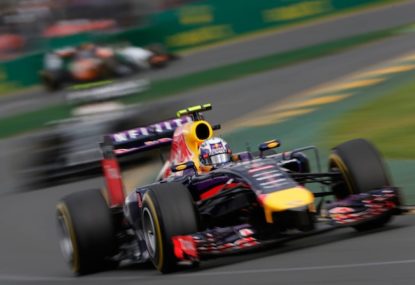Angry Carlos Sainz almost demands Oscar Piastri give back on-track spot after fierce battle
The Spanish driver claimed he was forced off the track while trying to overtake into fourth spot and wanted the McLaren driver to give…

The howls of protest over the new sound of Formula One were deafening compared to the muffled noise from the sport’s new-generation engines.
Formula One replaced its screaming 2.4-litre V8 engines with the more timid 1.6-litre V6 turbos, pushing for greener, more efficient powerplants that use 35 per cent less fuel than last season.
And the clear result is a much duller and reduced noise level, with the shattering intensity of the previous engines gone, leaving fans at the season-opening Australian Grand Prix last weekend to bemoan the lack of aural atmosphere.
As Formula One commentator and former driver Martin Brundle noted, “ear plugs were not really needed, the track PA system could be heard for the first time ever, and other sounds such as mechanical noise and tyre torture could be heard. But there simply isn’t enough volume and some of the intense drama has been lost.”
But with talk of artificially increasing the noise level to appease unhappy of fans and event organisers, it’s important to reflect on why the changes happened.
Motorsport categories around the world are struggling to find the balance between pure performance and power relative to market relevance.
And with just three engine manufacturers left in Formula One, the series needed to act to ensure its technology was relevant to the automotive sector, particularly at a time when sportscar racing is booming with the likes of Audi, Toyota, Porsche and co racing in the series to showcase their hybrid technologies.
Meanwhile, the engine changes will contribute to better racing, with the higher level of torque from the turbos, combined with less downforce, resulting in harder to drive cars.
That was evident throughout the Australian Grand Prix weekend, with the cars visibly harder to control in corners with rear-ends regularly stepping out.
Such a change was needed to make Formula One cars less predictable in a bid to improve the racing, and that was evident in the number of non-KRS and DRS (overtaking boosts) passes throughout the race.
Meanwhile, Daniel Ricciardo may have lost his second place but was nevertheless a big winner from the Australian Grand Prix, exceeding expectations on home soil.
Ricciardo was the only driver to get anywhere near the dominant Mercedes team over the event, despite the pressure of a home grand prix and debut with the championship-winning team.
While Australians bemoan the loss of Ricciardo’s second place (for breaching the mandated fuel flow rate during the racing), believing he should have avoided punishment for a team error, rules are rules and need to be black and white in such a highly technical sport.
Ricciardo and teammate Sebastian Vettel certainly face a tough ask this season to compete with the dominant Mercedes team, which claimed an easy win with Nico Rosberg.
The Mercedes-powered teams, including the factory team, McLaren, Williams and Force India, were all regulars in the top 10 and will have an early season advantage until the Renault and Ferrari-powered teams can make some gains.
In contrast to recent Vettel-dominated Formula One seasons, unreliability, poor-handling cars and a rejigged pecking order will make this season an intriguing one.
It’s just a shame about the noise…